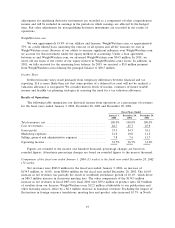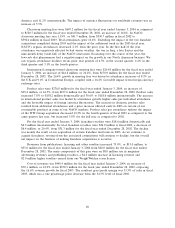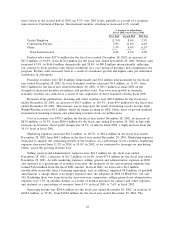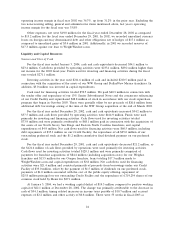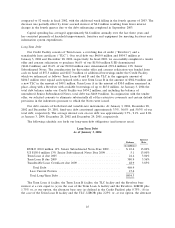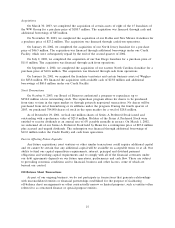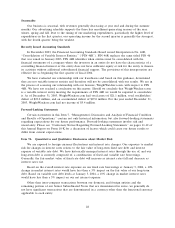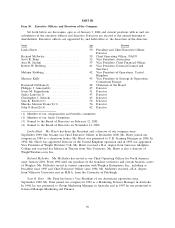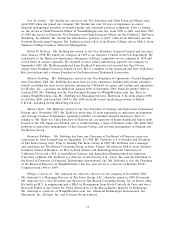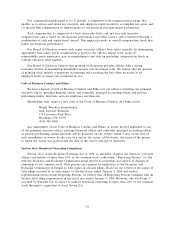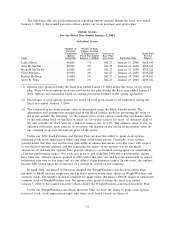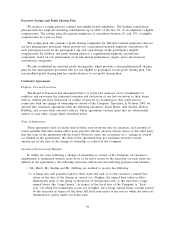WeightWatchers 2003 Annual Report Download - page 35
Download and view the complete annual report
Please find page 35 of the 2003 WeightWatchers annual report below. You can navigate through the pages in the report by either clicking on the pages listed below, or by using the keyword search tool below to find specific information within the annual report.We enter into forward and swap contracts to hedge transactions denominated in foreign currencies
to reduce the currency risk associated with fluctuating exchange rates. These contracts are used
primarily to hedge payments arising from some of our foreign currency denominated obligations.
Realized and unrealized gains and losses from these transactions are included in net income for the
period. In addition, we enter into interest rate swaps to hedge a substantial portion of our variable rate
debt. Changes in the fair value of these derivatives will be recorded each period in earnings for
non-qualifying derivatives or accumulated other comprehensive income (loss) for qualifying derivatives.
Fluctuations in currency exchange rates may also impact our shareholders’ equity. The assets and
liabilities of our non-U.S. subsidiaries are translated into U.S. dollars at the exchange rates in effect at
the balance sheet date. Revenues and expenses are translated into U.S. dollars at the weighted average
exchange rate for the period. The resulting translation adjustments are recorded in shareholders’ equity
as accumulated other comprehensive income (loss). In addition, fluctuations in the value of the euro
will cause the U.S. dollar translated amounts to change in comparison to prior periods. Furthermore,
we revalue our outstanding senior subordinated euro notes at the end of each period and the resulting
change in value will be reflected in the income statement of the corresponding period.
Each of our subsidiaries derives revenues and incurs expenses primarily within a single country
and, consequently, does not generally incur currency risks in connection with the conduct of normal
business operations.
We use foreign currency forward contracts to more properly align the underlying sources of cash
flow with our debt servicing requirements. At January 3, 2004, we had a long-term foreign currency
forward contract receivable with a notional amount of A8.4 million (approximately $10.6 million), offset
by a foreign currency forward contract payable with a notional amount of $9.2 million.
Item 8. Financial Statements and Supplementary Data
This information is incorporated by reference to the ‘‘Consolidated Financial Statements and
Notes’’ on pages F-1 through F-40, together with the report thereon of PricewaterhouseCoopers LLP
on page F-41.
Item 9. Changes in and Disagreements with Accountants on Accounting and Financial Disclosure
None.
Item 9A. Controls and Procedures
We maintain disclosure controls and procedures that are designed to ensure that information
required to be disclosed in our report under the Securities Exchange Act of 1934 is recorded,
processed, summarized and reported within the time periods specified in the Securities and Exchange
Commission’s rules and forms, and that such information is accumulated and communicated to our
management, including our Chief Executive Officer and Chief Financial Officer, as appropriate, to
allow timely decisions regarding required disclosures. Any controls and procedures, no matter how well
designed and operated, can provide only reasonable assurance of achieving the desired control
objectives. Our management, with the participation of our Chief Executive Officer and Chief Financial
Officer, has evaluated the effectiveness of the design and operation of our disclosure controls and
procedures as of January 3, 2004. Based upon that evaluation and subject to the foregoing, our Chief
Executive Officer and Chief Financial Officer concluded that the design and operation of our
disclosure controls and procedures provided reasonable assurance that the disclosure controls and
procedures are effective to accomplish their objectives.
In addition, there was no change in our internal control over financial reporting that occurred
during the quarter ended January 3, 2004 that has materially affected, or is reasonably likely to
materially affect, our internal control over financial reporting.
29


